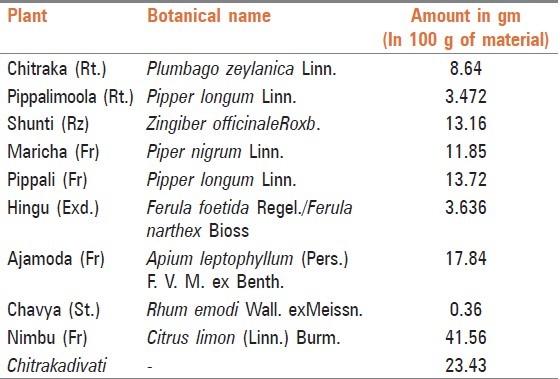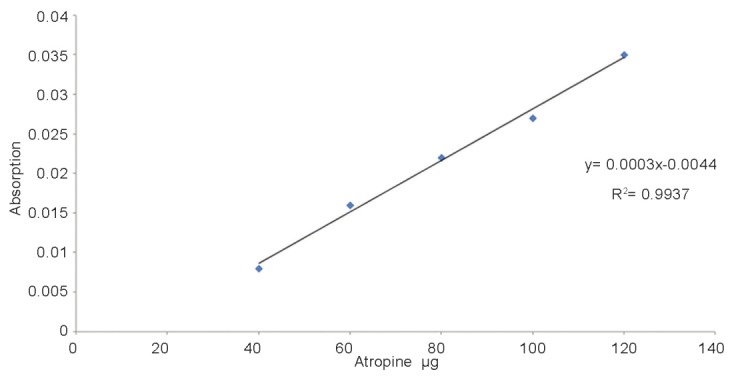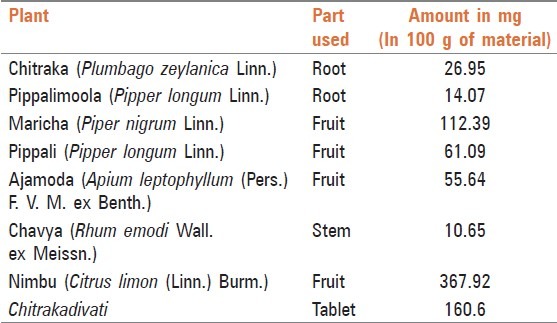Abstract
Background:
Herbal formulation standardization by adopting newer technique is need of the hour in the field of Ayurvedic pharmaceutical industry. As very few reports exist. These kind of studies would certainly widen the herbal research area. Chitrakadivati is one such popular herbal formulation used in Ayurveda. Many of its ingredients are known for presence of alkaloids.
Methodology:
Presence of alkaloid was tested qualitatively by Dragondroff's method then subjected to quantitative estimation by UV-Spectrophotometer. This method is based on the reaction between alkaloid and bromocresol green (BCG).
Results and Conclusion:
Study discloses that out of 16 ingredients, 9 contain alkaloid. Chitrakadivati has shown 0.16% of concentration of alkaloid and which is significantly higher than it's individual ingredients.
KEY WORDS: Bromocresol green, chitrakadivati, total alkaloid, UV-Spectrophotometer, ayurveda
INTRODUCTION
The herbal drug standardization is indeed bustle in Ayurveda. There are many contradictory theories on the subject of herbal medicines and their relationship with human physiology and mental function.[1] Chemo profile of Ayurvedic drugs or herbal medicines are limited. Development of this would certainly help to widen the standardization of herbal medicine and also to predict the action of drugs and drug interaction if used in clinically.[2] There are many challenges in front of Ayurveda drug industry which are raw drug standardization, product analysis, along with drug safety issues which include heavy metal contain, negative criticism of Ayurvedic formulations and increased toxicity reports.[3,4] Hence, to tackle these issues there is need to develop evaluative data by using sophisticated modern techniques of standardization of Ayurvedic formulations. These kinds of studies will help in understanding the pharmacokinetics and safety of herbal formulation.
The Alkaloids are naturally occurring nitrogen-containing pharmacologically active organic compounds present in plant kingdom. These have made major impact on plant medicine because of its vast application. A research in 1985 suggested that there are more than 140 Angiospermic plant families and 20,000 genuses are rich with alkaloids.[5] In Ayurveda it is believed that many of Tikta (bitter) and Katu (pungent) tasted herbs are rich in alkaloids.
“Chitrakadivati” is a poly-herbal Ayurvedic medicine[6] used as carminative in spasmodic and mal-absorption syndrome. It also restores normal digestive functions. Many of its ingredients are Katu (pungent) in taste and have alkaloid as a prime chemical constituent hence present research work was under taken to know the total quantity of alkaloid in this formulation by UV-Spectrophotometer.
Many methods are reported for the determination of alkaloids which include HPLC,[7] fluorimetry,[8] ionchromatography,[9] coulometry,[10] gas chromatography,[11] and electro chromatography.[12] Spectrophotometric method is known for its simplicity, sensitivity, and rapid determination. This method is based on the reaction of alkaloid with bromocresol green (BCG), forming a yellow colored product.[13]
MATERIALS AND METHODS
Plant material
Chitrakadivati is consists of 16 ingredients, viz., Plumbago zeylanica Linn, Pipper longum Linn (root), Zingiber officinale Roxb, Piper nigrum Linn, Pipper longum Linn (fruit), Ferula foetida Regel./Ferula narthex Bioss, Apium leptophyllum (Pers.) F. V. M. ex Benth, Rhum emodi Wall. ex Meissn, Yavakshara (ash of Hordeum vulgare Linn), Sarjikshara (Impure carbonate soda/Dhobis earth), Sauvarchala Lavana (Sochal salt), Saindhava Lavana (Sodium chloride), Vida Lavana (Ammonium salt), Samudra Lavana (Sea salt), Audbhida Lavana (Rahe salt) and Citrus limon (Linn.) Burm.[14]
All these ingredients were procured from the local market of Belgaum, Karnataka, India, and were authenticated at central research facility of KLE University's Shri B.M.K. Ayurved Mahavidhyalaya Belgaum, Karnataka, India.
Preparation of Chitrakadivati
The Churna (powder) was prepared as per the procedure given in Ayurvedic Formulary of India.[14] All the ingredients (except Citrus limon (Linn.) Burm) were powdered separately, passed through 80 # sieve and then mixed together in specified proportions to get uniformly blended churna. 500 mg Vati (tablets) was prepared by adding quantity sufficient of Citrus limon (Linn.) Burm. Juice, then dried and stored in air tight bottle.
Extraction
The 100 gm of each plant material was ground and then extracted with methanol for 24 hours in a continuous extraction (Soxhlet) apparatus. The extract was filtered and methanol was evaporated on a rotary evaporator under vacuum at a temperature of 45°C to dryness.
Qualitative estimation (Test for alkaloids)
Presence of alkaloid was confirmed by Dragendroff's method.[15] A part of extract was dissolved in dilute HCL and 2 drops of Dragon drop's was added, a crystalline precipitate indicates presence of alkaloid. The sample which showed positive alkaloid was then subjected to further quantitative evaluation.
Preparation of reagents
Bromocresol green solution was prepared by heating 69.8 mg bromocresol green with 3 ml of 2N NaOH and 5 ml distilled water until completely dissolved and the solution was diluted to 1000 ml with distilled water.
Phosphate buffer solution (pH 4.7) was prepared by adjusting the pH of 2M sodium phosphate (71.6 gm Na2HPO4 in 1 L distilled water) to 4.7 with 0.2 M citric acid (42.02 gm citric acid in 1 L distilled water).
Atropine standard solution was made by dissolving 1 mg of pure Atropine (AR-grade procured from Sigma Company) in 10 ml distilled water.
Seperation of Alkaloid
A part of extract residue was dissolved in 2N HCL and then filtered. 1 ml of this solution was transferred to separatory funnel and washed with 10 ml chloroform (3 times). The pH of this solution was adjusted to neutral with 0.1 N NaOH. Then 5 ml of BCG solution and 5 ml of phosphate buffer were added to this solution. The mixture was shaken and complex extracted with 1, 2, 3 and 4 ml chloroform by vigorous shaking, the extract was then collected in a 10 ml volumetric flask and diluted with chloroform.
Preparation of standard curve
Accurately measured aliquots (0.4, 0.6, 0.8, 1 and 1.2 ml) of Atropine standard solution was transferred to different separatory funnels. Then 5 ml of pH 4.7 phosphate buffer and 5 ml of BCG solution was taken and the mixture was shaken with extract with 1, 2, 3, and 4 ml of chloroform. The extracts were then collected in 10 ml volumetric flask and then diluted to adjust solution with chloroform.
The absorbance of the complex in chloroform was measured at spectrum of 470 nm in UV-Spectrophotometer (SHIMADZU UV-1800) against the blank prepared as above but without Atropine.
RESULTS AND DISCUSSION
5-Lavanas (salts), 2-ksharas (Sajjikshara and Yavakshara), Zingiber officinale Roxb. And Ferula foetida Regel./Ferula narthex Bioss showed negative to qualitative alkaloid examination hence were excluded from the quantitative assessment.
Methanol extractive value shows that Vati (tablet) has significantly higher (23.43 gm per 100 gm) than other of its ingredients shows in Table 1.
Table 1.
Determination of methanol extractive value

A yellow colored complex with a maximum absorption was developed. This complex was completely extractable by chloroform at pH 4.7. A calibration curve was plotted for various concentrations of atropine [Figure 1].
Figure 1.

Atropin accuracy curve
In our results Nimbu (Citrus limon (Linn.) Burm) has shown higher extractive value and also alkaloid content since ripen fruit (includes covering and other fibers of fruit) has been assessed instead of its juice.
Chitrakadivati significantly shows high total alkaloid content 160.6 mg (per 100 gm of total vati) i.e. 0.16% than Maricha (Piper nigrum Linn.) 112.39 mg or Chitraka (Plumbago zeylanica Linn.) 26.95. Among its ingredients, Maricha (Piper nigrum Linn.) was highest with 112.39 mg than Pippali (Pipper longum Linn.) 61.09 mg, Pippa limoola 14.07 mg, Ajamoda (Apium leptophyllum (Pers.) F. V. M. ex Benth.) 55.64 mg, Chavya (Rhum emodi Wall. ex Meissn.) 10.65 mg or Chitraka (Plumbago zeylanica Linn.) 26.95 mg showed in Table 2.
Table 2.
Determination of total alkaloids in tested plant materials by bromocresol green-complex formation

Quantification of Ayurvedic compound formulation is the need of the hour since obtained data can be used in future pharmacokinetic study.
Limitations
The BCG can only react with a certain class of alkaloids (alkaloids that have nitrogen inside their structure and amine or amid alkaloids does not react with this reagent hence obtained data may provide gross understanding of total quantity of alkaloid in drug. Also in place of Nimbu juice whole fruit was assessed.
CONCLUSION
Results presented in this study reveal that Chitrakadivati contains 0.16% of total alkaloids according to UV-Spectrophotometer method. This is the first report of quantitative standardization of Chitrakadivati by using Spectrophotometric method.
ACKNOWLEDGMENT
Author's are grateful to the Institute KLEU Shri BMK Ayurved Mahavidhyalaya for financial support of this investigation. Also extends our sincere thanks to Dr. B S Prasad Principal, Dr. R C Mathad Academic in charge and HOD of Dravyaguna KLEU Shri BMK Ayurved Mahavidhyalaya, Belgaum and Dr. Hullati KLE Pharmacy college Belgaum, for their valuable support and encouragement.
Footnotes
Source of Support: KLE University's BMK Ayurveda Mahavidhyalaya Belgaum, Karnataka.
Conflict of Interest: Funded by KLE University's Shri BMK Ayurved Mahavidhyalaya Belgaum.
REFERENCES
- 1.Sriwastava NK, Shreedhara CS, Aswatha Ram HN. Standardization of Ajmodadichurna, a polyherbal formulation. Pharmacognosy Res. 2010;2:98–101. doi: 10.4103/0974-8490.62957. [DOI] [PMC free article] [PubMed] [Google Scholar]
- 2.Qureshi S, Diab Al A, Al-Anazi FA, Al-Hassan MI, Qureshi MF, Qureshi VF, et al. Negative aspects of the beneficial herbs: An over view. J Herb Med Toxicol. 2012;6:1–14. [Google Scholar]
- 3.Saper BR, Phillips SR, Sehgal A, Khouri N, Davis BR, Paquin J, et al. Lead, mercury, and arsenic in US- and Indian-manufactured Ayurvedic medicines sold via the internet. [Last accessed on 2010 Oct 4]. Available from: http://jama.ama-assn.org/cgi/content/full/300/8/915 . [DOI] [PMC free article] [PubMed]
- 4.Saper BR, Kales NS, Paquin J, Burns JM, Eisenberg MD, Davis BR, et al. Heavy metal content of Ayurvedic herbal medicine products. [Last accessed on 2010 Oct 4]. Available from: http://jama.ama.assn.org/cgi/content/full/292/23/2868 . [DOI] [PubMed]
- 5.Armin G, Manfred H, editors. Alkaloids: The University of Zurich publication; 2009. [Last accessed on 2012 Mar 11]. p. 479. Available from: http://www.scribd.com/doc/16523775/Alkaloids . [Google Scholar]
- 6.Sharma RK, editor. “15th Adhyaya in chikitsastana” of Charaka Samhita (English) 1st ed. Vol. 4. Varanasi: Chaukhambha Sanskri Sansthan, Varanasi (UP); 2005. p. 41. [Google Scholar]
- 7.Qi M, Wang P, Lang YX, Lang JL, Fu RN. Simultaneous determination of caffeine, theophylline, and theobromine by HPLC. J Chromatogr Sci. 2002;40:45–8. doi: 10.1093/chromsci/40.1.45. [DOI] [PubMed] [Google Scholar]
- 8.Masatoki K, Hirokazu T. Fluorometric reactions of purines and determination of caffeine. Talanta. 2000;36:1171–5. doi: 10.1016/0039-9140(89)80047-5. [DOI] [PubMed] [Google Scholar]
- 9.Qing-Chun C, Wang J. Simultaneous determination of artificial sweeteners, preservatives, caffeine, theobromine, and theophylline in food and pharmaceutical preparations by ion chromatography. J Chromatogr. 2001;937:57–64. doi: 10.1016/s0021-9673(01)01306-1. [DOI] [PubMed] [Google Scholar]
- 10.Chernyseva NN, Abdullin IF, Bundikov GK. Coulometric determination of purine alkaloids series with electrogenerated chlorine. J Anal Chem. 2002;56:663–5. [Google Scholar]
- 11.Cai J, Liu B, Lin P, Su Q. Fast analysis of nicotine related alkaloids in tobacco and cigarette smoke by megabore capillary gas chromatography. J Chromatog A. 2003;1017:187–93. doi: 10.1016/j.chroma.2003.07.003. [DOI] [PubMed] [Google Scholar]
- 12.Pagliariussi RS, Frietas AP, Bastos JK. A quantitative method for the analysis of xanthine alkaloids in Paulliniacupana (guarana) by capillary gas chromatog-raphy. J Sep Sci. 2002;25:371–4. [Google Scholar]
- 13.Shamsa F, Monsef H, Ghamooshi R, Verdian-rizi M. Spectrophotometric determination of total alkaloids in some Iranian medicinal plants. Thai J Pharm Sci. 2008;32:17–20. [Google Scholar]
- 14.Government of India, Ministry of Health and family welfare. 2nd revised edition. New Delhi: Department of ISM and H; 2003. The Ayurvedic Formulary of India, Part-I; p. 186. [Google Scholar]
- 15.Trease GE, Evans WC. Pharmacognosy. 15th ed. Philadelphia: WB Saunders, Elsevier Science Limited; 2002. p. 336. [Google Scholar]


